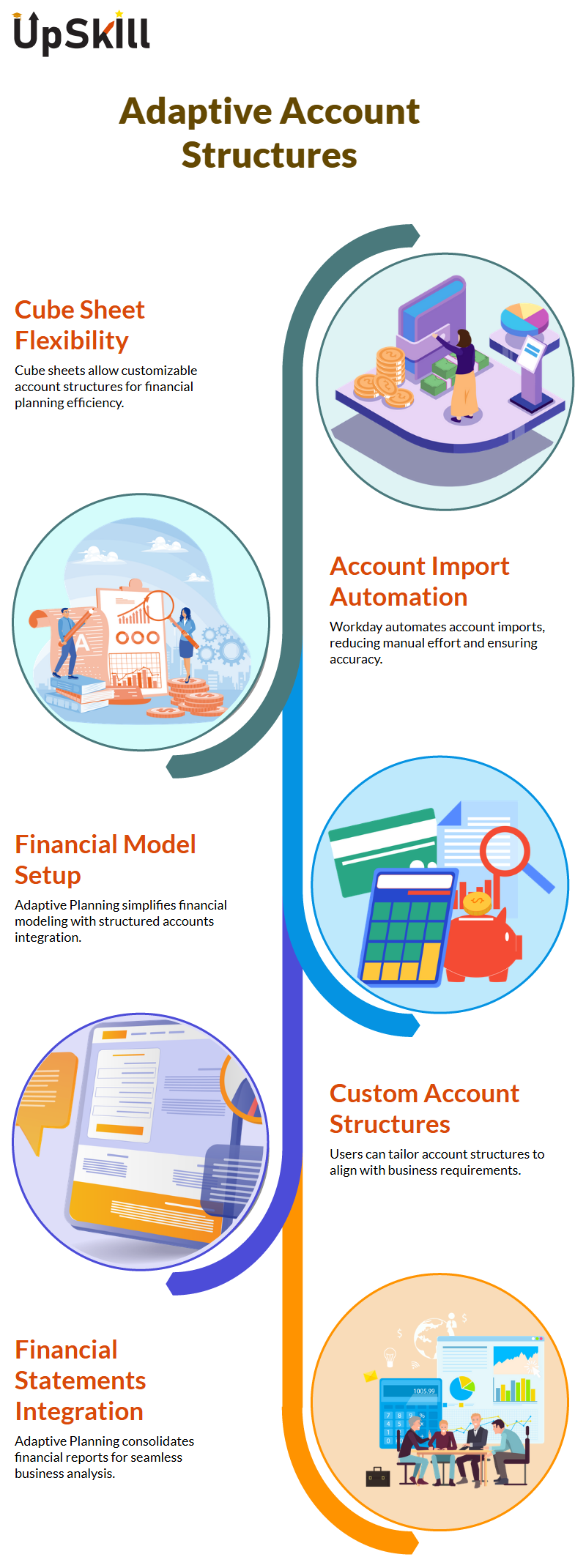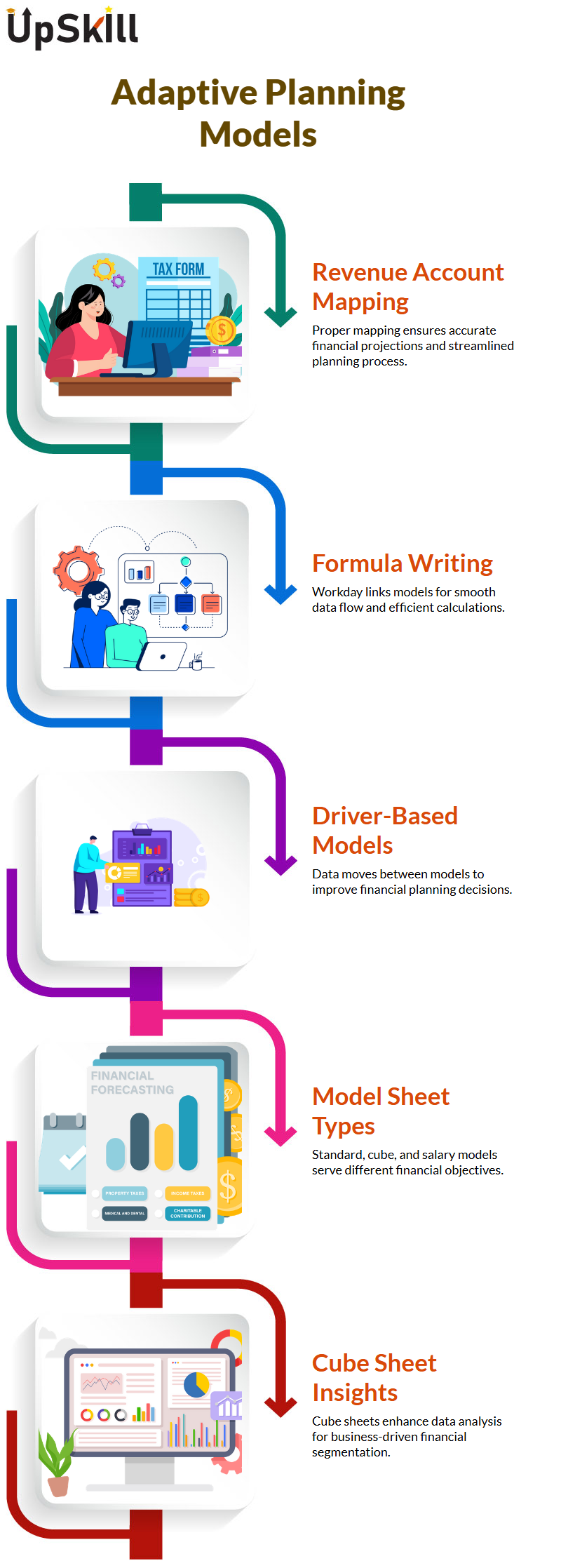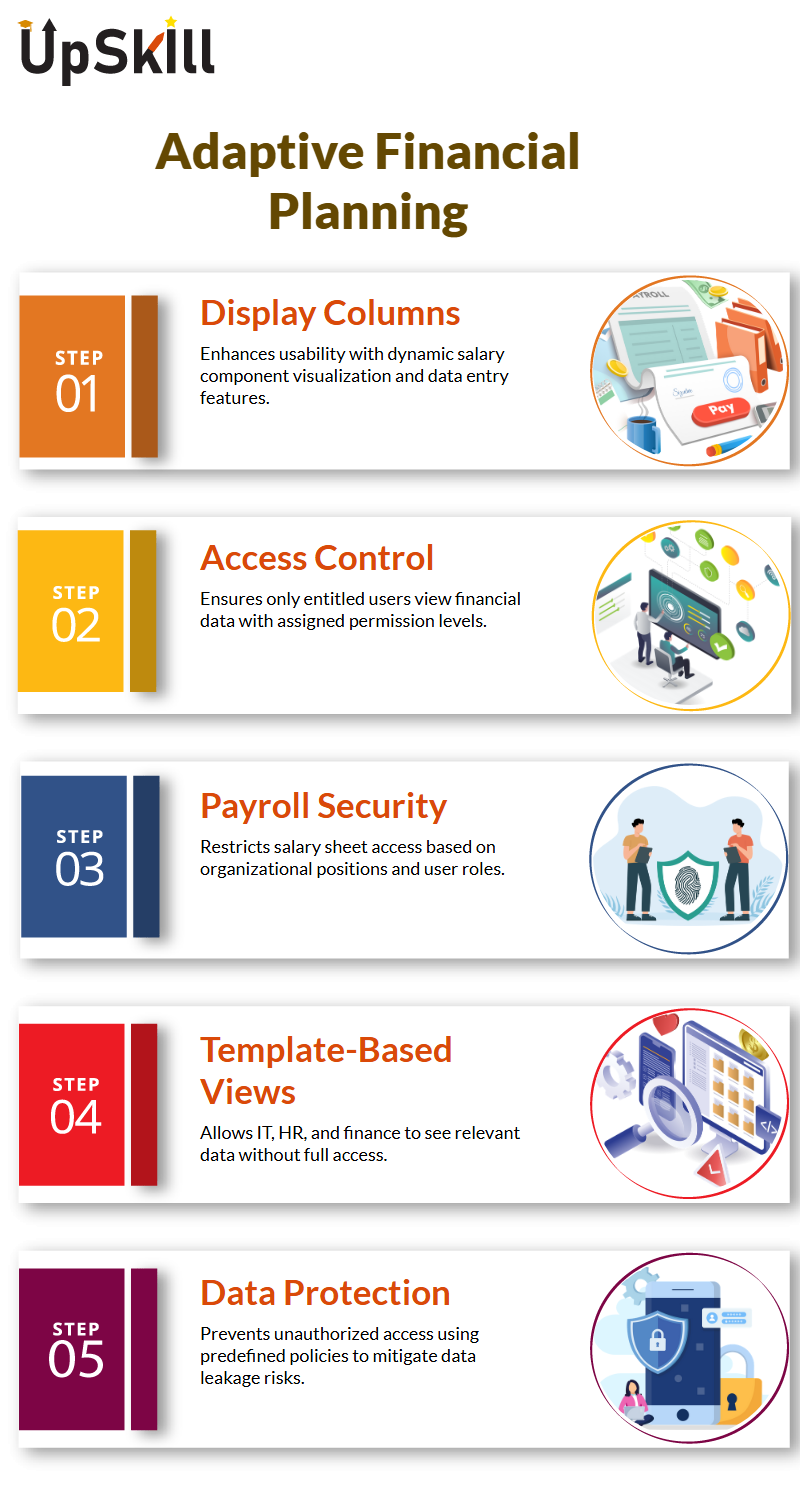Top Workday Training Institutes in Bengaluru near me
Workday Adaptive Planning Tutorial
Workday Adaptive Planning Account Structures
We must first understand well how account structures work on different model sheets in Workday Adaptive Planning.
In case you are working with geo accounts, metric accounts, ritual accounts, or assumption accounts, these accounts would be placed in a cube model or model sheet so that there would be usability for them or they can be withdrawn from the system.
Workday Adaptive presents the flexibility to choose the account structures entry in cube sheets.
Nonetheless, the performance of the tab is not present in a model sheet which is to say cube sheets offer a more straightforward way of adding account type like ceremony and general ledger accounts while the same in model sheets needs a different way of doing things.
Dwelling Account Structures in Workday Adaptive Planning
Making use of the Workday Adaptive Planning tool to set up the accounting structures keeps the cost of upkeeping a small financial model down.
The Cube sheets come with a series of solutions standard accounts, calculated accounts, assumption accounts, and metric accounts.
The software has the assurance of having the latest resources that are required for the financial plan. Workday Adaptive Planning Tutorial in Bengaluru is especially useful for understanding how to manage these solutions effectively.
Through Workday Adaptive Planning, it is possible to add general ledger and ritual accounts into the cube sheets.
This detail gives the user the ability to individualize the account structure according to the enterprise’s business mandates, facilitating smooth integration with the financial planning process.
Workday Adaptive Planning for Financial Statements
Workday Adaptive Planning is involved in earning financial statements (e.g. profit and loss statements, balance sheets, and cash flow reports) into a coherent form.
These worksheets are very popular and are used for the best financial reporting.
When developing a financial model, it is indispensable to follow a certain plan prescribed by Workday Adaptive Planning.
There are three major steps in this method. Initially, the decision on what type of a sheet will be used in the financial planning process lays the groundwork. Greater, the application of a suitable account structure is required to be made. Workday Adaptive Planning Tutorial in Bengaluru is ideal for which users through these planning steps.
Accounts in Workday Adaptive Planning
Workday Adaptive Planning automates account import to avoid red tape. A user in need of new data can easily get it from the models.
Try this link for more solutions if you want to import models without a protraction and also check the import section for some more details.
Moreover, the process of accounts import always permits the participation of superficial providers of account structures through standard import routines.
In case a new set of account structures is imperative, users have the ability to download templates, complete accounts, and later, import them into the system fluently.

Revenue and Sales Accounts for Workday Adaptive Planning
Workday Adaptive Planning is a key tool in the prediction of revenue and sales accounts whereby actuals come from systems such as EBS; it is essential to undertake proper account mapping for right projections.
With cube sheets, the Workday Adaptive Planning tool makes the whole process simple. Therefore, model sheets will need to be manually linked to the accounts, which in turn will lead to more elaborate planning.
Understanding this difference is a highlight of the Workday Adaptive Planning Tutorial in Bengaluru, involves users often get hands-on experience.
Writing of Formulas in Workday Adaptive Planning
One of the key concepts in Workday Adaptive Planning is writing formulas. If there are questions on how assorted models in Workday Adaptive Planning are related, this section clarifies it.
Everything is constructed from the ground up as each model corresponds to another to make a smooth data flow.
Typically, model linkage in Workday Adaptive Planning is used for account referencing. For prototype, in Workday Adaptive Planning, it is possible to build a tradition account that connects different components inside of a model.
Workday Adaptive Planning Tutorial in Bengaluru helps apply this practice to real-time projects to see how these accounts affect the profit & loss statement.
Driver-Based Models in Workday Adaptive Planning
A “driver-based model” refers to the models in Workday Adaptive Planning where the data moves between models.
This concept is a major focus in every Workday Adaptive Planning Tutorial in Bengaluru conducted for financial planning teams.
To organize planning data, this step is an important one. Workday Adaptive Planning gives the option of connecting the sheets, thus leading to the right decision.
Releases clarify it: Should another calculated account be created, such as a metric account, Workday Adaptive Planning will process it differently than standard accounts.
It won’t add up the percentages, but it will roll up the figures correctly by capitalizing on a structured strategy.
How to Fabricate Models in Workday Adaptive Planning
The processes of data integration in Workday Adaptive Planning include manual data entry, imports, integrations, a range of types of sheets, simple formula writing, and driver-based models. Workday Adaptive Planning ensures that the data is sorted in the right way.
There are three types of models commonly used: a standard sheet model, a cube model, and a salary model. Each model has different objectives in Workday Adaptive Planning.
The regular sheet is used to log the time, stages, versions, and accounts while the cube model brings forward the dimensions for more in-depth analysis of data.
Cube Sheets in Workday Adaptive Planning
Understanding how Workday Adaptive Planning cube sheets add value to data analysis is important.
A good example of this is a cube sheet which gives the user the ability to interact with a lot of different angles, such as the profit from goods sold for the products, as well as the colors of the products or even the gender of the final customer.
According to the text, Workday Adaptive Planning cube sheets transport great results on the subject of easily performing assorted types of research.
It’s also conjectured that determining cube sheets over regular sheets is a more favorable way to go for analysts who want to achieve the best kind of data segmentation in order to make augmented-informed choices.
Why Model Sheets are Important in Workday Adaptive Planning. A Workday Adaptive Planning model sheet ensures that Human Resources facts are handled completely.
Spreadsheet models can be used to adjust functions, salaries, and demographic alternatives if regular or cube sheets are not enough.
Workday Adaptive Planning will always keep the confidential salary data protected. Employment restrictions mean that only the employees involved can see the details.
This controlled accessibility is one of the core features covered in Workday Adaptive Planning Tutorial in Bengaluru.

Workday Adaptive Planning with the Use of Display Columns
Workday Adaptive Planning model sheets provide extra serviceability such as data entry specialties and display columns. Workday Adaptive Planning is thus enhanced by these features.
The system automatically calculates table salary components: plain pay, bonus, and total salaries, and each salary component can be displayed dynamically.
This is a progress from the traditional way of doing things and gives a transparent picture of the financial status.
Cognizance Workday Adaptive Planning
For any organization, retaining assured and suitable access to vital financial data is key. Workday Adaptive Planning Tutorial in Bengaluru is the solution that comes with a managed method to guarantee only the subjects entitled can have access to specialty sheets.
Suppose there are 100 employees and only five of them are the HR team and have to work with the salary computation model.
The remaining 95 will of course not be able to access this sheet. What is the distinctive aspect of Workday Adaptive Planning?
Can the sheet owners be the leader or manager via a level-assigned sheet or user-assigned sheet? This depends on understanding their definite use examples.
If access must be limited according to positions in the organization, Workday Adaptive Planning furnishes level-assigned sheets.
When access needs to be specified for users recognized by the system, user-assigned sheets are used.
Setting Up Workday Adaptive Planning Sheets
Working on Workday Adaptive Planning, we have planned a payroll model and gave permissions according to positions.
This implies that the data can be seen only by users in some provinces, such as the USA Surrounded by the USA, we manually choose which places we want to grant access to, e.g., New York, Philadelphia, and Chicago, leaving out the relaxation of the employees outside these cities.
With user-assigned sheets, in a similar string to access to those who are assigned, a few users only will have it by permitting the view to be given to the five HR employees, we assure that the confidential payroll data inside.
Workday Adaptive Planning is safe Once we interpret a sheet to be user-assigned; the access will be allocated to only those that are there in the list.
Views and Permissions in Workday Adaptive Planning
Among the issues faced by Workday Adaptive Planning is that keeping different users glancing at only what they need to see and also verifying security are easy to cope with at the same time.
We do not want to craft separate sheets for each team; thus, we decide to use templates. The templates are set up in a way that IT, HR, and finance are able to view only essential columns, while the break of the data is still unavailable.
We are additionally granted the authority to adjust reports Dashboards, and so on are capable of controlling the degree of visibility by, for demonstration, the finance department solely have access to pay-related columns.
For further clarity, a Workday Adaptive Planning Tutorial in Bengaluru may demonstrate the benefits of template-based visibility.
While the IT department retrieves operational data Workday Adaptive Planning is a tool that presents users’ access structures according to predetermined policies to avoid causing data leakage risks. alienation of empathetic data

Workday Adaptive Planning Security Features
Workday Adaptive Planning comprises a line of defense to establish data visibility control and protection from unauthorized access.
In case we are required to restrict access to the certain employee data, for representation, not to display the details of contracts, we get this through security settings where Admins control column visibility, this way guarantee that users only obtain what they really need.
Also, Workday Adaptive Planning authorizes role-based permissions where through the user groups (e.g. ‘Admin Users’ or ‘Finance Users’) we permit a perfect process of access management.
To deepen understanding of this setup, one could refer to a Workday Adaptive Planning Tutorial in Bengaluru.
Instead of granting permissions one by one, we easily set group access and assure data security without any hassle.

